The Indo-European Connection
https://youtu.be/SqK7XXvfiXs
Proto Indo European Origins - Who Were They? How do we know?
https://youtu.be/jskt2Y_FEU4
The Migration of Indo-European Languages
https://youtu.be/Sdm9ACB8dTo
Yamnaya: Faces of the Indo-Europeans
https://youtu.be/d48bhkOiEuA
...............................................................
https://youtu.be/SqK7XXvfiXs
Proto Indo European Origins - Who Were They? How do we know?
https://youtu.be/jskt2Y_FEU4
The Migration of Indo-European Languages
https://youtu.be/Sdm9ACB8dTo
Yamnaya: Faces of the Indo-Europeans
https://youtu.be/d48bhkOiEuA
Viet
Why does Vietnamese, a tonal language in the Austroasiatic family, use the Latin alphabet, which comes from non-tonal languages in the Indo-European family? Why didn't the Vietnamese create their own alphabet?
Tại sao tiếng Việt, một ngôn ngữ âm trong gia đình Austroasiatic, sử dụng bảng chữ cái Latinh, xuất phát từ các ngôn ngữ không âm trong gia đình Ấn-Âu? Tại sao người Việt Nam không tự tạo ra bảng chữ cái cho riêng họ?
Because we found that this Western-based alphabet actually helped us defeat a Western colonial power. Then, after using Alphabet in writting, Vietnamese people realize that it much easier to use Alphabet than using stroke characters in writting, it's best way and quick way for Vietnamese people to get educated anyway, (even we have chữ Nôm and chữ Khoa Đẩu but they were still in constructed).
Bởi vì chúng tôi thấy rằng bảng chữ cái dựa trên phương Tây này thực sự đã giúp chúng tôi đánh bại một cường quốc thuộc địa phương Tây. Sau đó, sau khi sử dụng Alphabet bằng văn bản, người Việt Nam nhận ra rằng việc sử dụng Alphabet dễ dàng hơn nhiều so với việc sử dụng các ký tự nét bằng cọ lông, đó là cách tốt nhất và nhanh chóng để người Việt Nam được giáo dục, (ngay cả chúng ta cũng có chữ Nôm và chữ Khoa Đẩu nhưng chúng vẫn đang xây dựng).

Viet
This is the major ethnic group of Vietnam, giving its name to the country, and comprising a mathematical majority of the population. They call themselves Kinh, and the major part of the population lives in the Mekong and Red river deltas, as well as in a narrow band along the coast. They also inhabit an island in China, where they are known as the Jing. Their language forms one branch of the Austro-Asiatic language family, along with Muong. The distribution is indicated in the following map by pink.


• Kra–Dai
• Austronesian
• Austroasiatic
• Hmong–Mien
• Sino-Tibetan
The current national outfit of the Viet is called Ao Dai. This was fully developed in early the 20th century. The image above shows a couple in Ao Dai fit for a wedding. Here is another couple in a less formal version.
1
There is a great variety in color and detail, and designers keep making more. This dress is still commonly worn for holidays, Tet, and weddings.
2
3
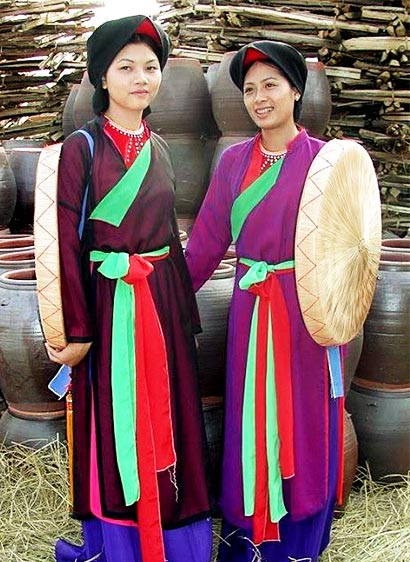
4

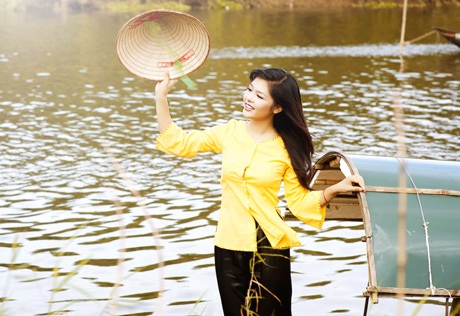
5

6
66

7
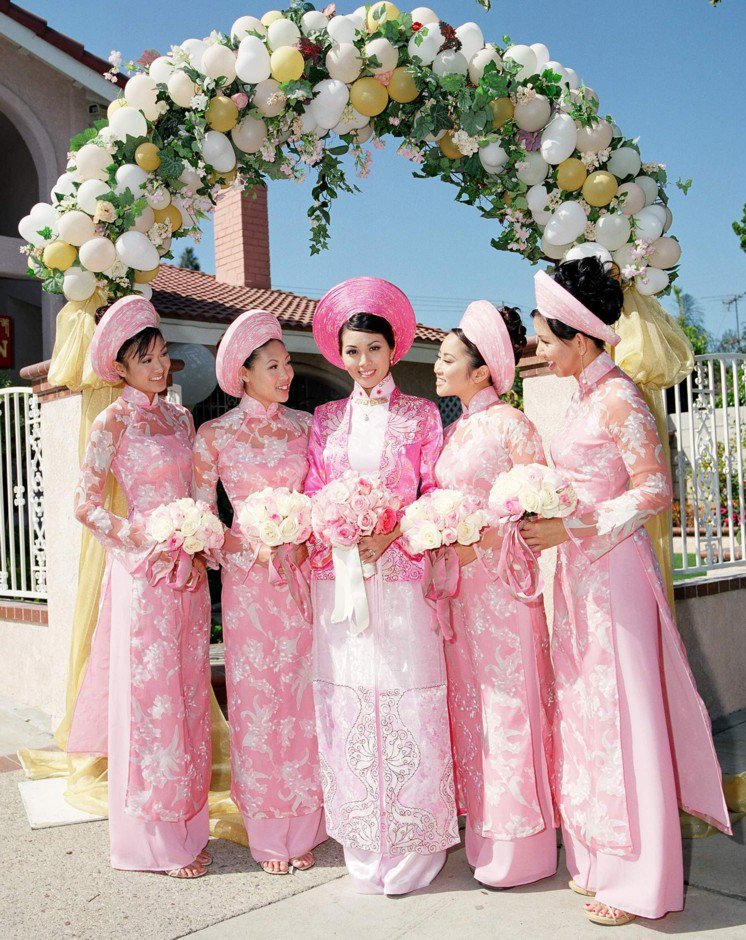
8
9
10

Here are some more the Ao Dai.
https://youtu.be/uz2ADoefJao
Wilcox High School Multicultural 2016: VSA
Muong
The Muong are closely related to the Viet linguistically. Their territory is inland of the northern range of the Viet people, but does not extend to the highlands. They call themselves the people in the middle, between the Kinh and the Highlanders. They number roughly 1.3 million.
Here is a short clip of Muong people dancing
https://www.youtube.com/watch?v=8avReumhyrI
Cham
The Cham, unlike most of the peoples of this region, are Austronesian, and not AustroAsiatic. It is speculated that they originally came from Borneo. They founded and ruled the Kingdom of Champa in what is now south central Vietnam from 192 to 1832. The spread of the Viets at that time resulted in the disappearance of Champa. Some of the people are still there, others fled to Cambodia, where many still live, some moved back into the highlands, and some went to northern Sumatra, where they became the Aceh. Here is a map of Champa, in green, at about the year 1000.
Here are maps showing the location of Cham people in both Vietnam and Cambodia.
Here are some examples of the costume of the Cham people.
1
2
3
4
5
6
7
8
9
10
11
12
13 A dance of the Cham
https://www.youtube.com/watch?v=N48AAb2E8uY
14 Montagnards or Highlanders
Inland from the Cham are the southern Highlands. These are inhabited by a number of tribal peoples, some speaking languages related to Cham, others speaking languages of the Bahnaric branch of the Austro Asiatic language family. These are often referred to collectively as the Highlanders, or Montagnards [French for Highlander]. Here is a map showing the rough extant of these peoples in Vietnam. They are also found across the border in adjacent parts of Cambodia and Laos. Many of these have similar costumes.
Here is a Vietnamese news report on the traditional music of he highlands. There are clips of M'nong, Giarai, and Ede dancing, among others
https://www.youtube.com/watch?v=dBhLEwPNtb8
Chamic Highlanders
These are represented by the light green area on the map above. and also extend over the border into Cambodia
Churu
Raglai
A dance of the Raglai people
https://www.youtube.com/watch?v=EY2mxxw-oQI
Ede
Also called E de or Rhede
Giarai
Also spelled Gia Ray or Jarai

Bahnaric Highlanders
These tribes speak languages of the Bahnaric branch of the Austro Asiatic language family, and are found to the south, west, and north of the Chamic speaking tribes, being found also in Cambodia and Laos.
M'nong
This is the major tribe which is found to the south.
Bahnar
This tribe lives to the north of the Chamic Highlanders. In Vietnamese, this tribe is called Ba Na.
Sedang
In Vietnamese, Xo Teng.
Katu
The Katu are not one of the Bahnaric tribes, but speak a language from yet another branch of the AustroAsiatic language family. You can see that their costume is significantly different from the tribes above.
This concludes this article. The rest of the peoples of the northern part of Vietnam are of the Kam-Tai [Tai-Kadai], Miao-Yao [Hmong-Mien], and Tibeto Burman language families, and have more in common with populations in Laos, Thailand, Myanmar, and neighboring parts of China.
I hope that you have found this to be interesting and informative.
Roman K
Source: http://folkcostume.blogspot.com/2017/10/introduction-to-some-of-folk-costumes.html
H' Mong in Vietnam, H' Mong in Vân Nam and Oversea H' Mong in United State of America
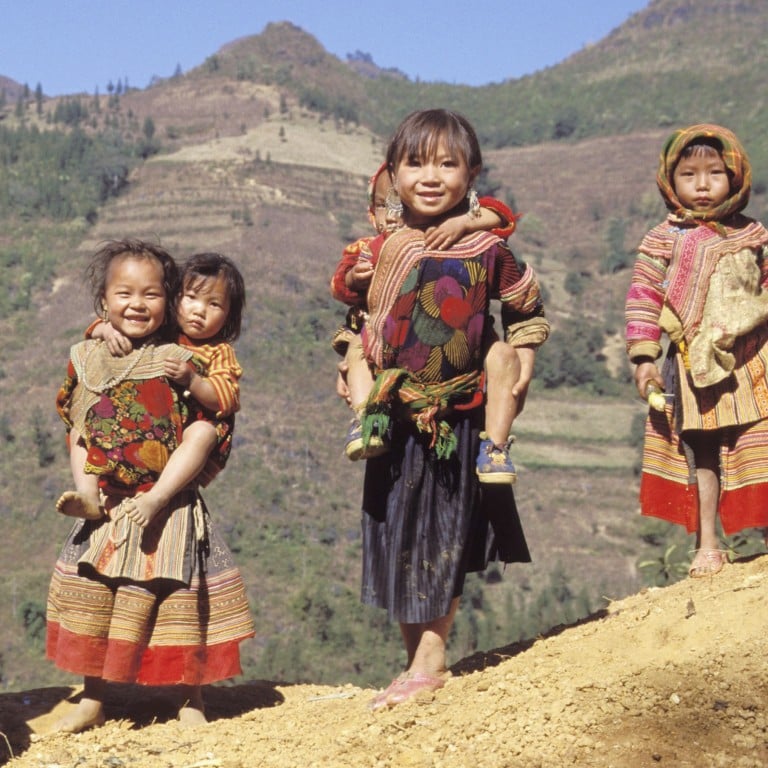

https://youtu.be/BHSqq7sLKH4

Lac Viet means Sea Birds Tribe along with other tribes
The languages in Southeast Asia largely fall into five groups:
• Kra–Dai
• Austronesian
• Austroasiatic
• Hmong–Mien
• Sino-Tibetan

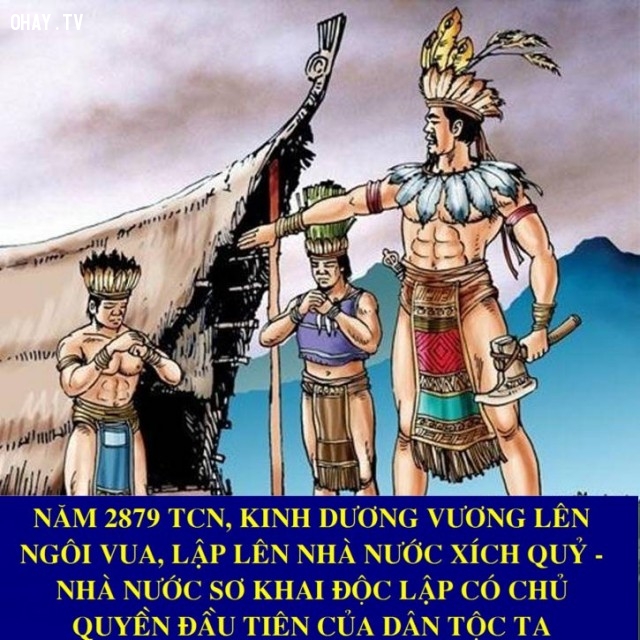
Indigenous people in South East Asia were the one who used the axes in ceremony, in procession as shown on this character 越, similar to the picture above and below.
Compare the picture above with the picture on Dong Son brass drum, both using axes for ceremony, both wearing feathers head gears.
Notice the dancing girls on the Dong Son brass drum were wearing horns.
The Yue people 越 were shown on Dong Son brass drums and on other brass drums in Southern China. The Yue people were associated with the dagger-axe: 戈 are indigenous people, before the Chinese people invasion/took land of these aboriginal Viet.
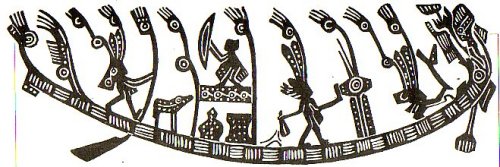
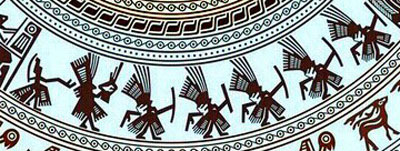
Lịch sử Bách-Việt còn hay nhắc lại những khám phá ra việc người Việt giỏi dùng ghe, thuyền di chuyển trên sông biển và trồng lúa, cắt tóc ngắn để dễ làm việc đồng án ở ruộng lúa nước… người Việt tiền sử có tục xâm mình, vẽ mặt, đội lông chim, điều nầy cũng thấy rõ ở thổ dân Châu ÚC và Châu Mỹ La-tinh.
Aboriginal Viet
Dongson culture also spoke a Kra-Dai language such as:
Guangdong, Guangxi, northern Vietnam was most likely Kra-Dai.
This is the Dong Son culture, one of the important ancient cultures of Southeast Asia.

Maritime Southeast Asia, from about 1000 BC to 1 BC.
Au & Lac Tribes/Vietnam

Traditional dress of the Dayak, an Austronesian tribe, in Borneo, Indonesia.

The indigenous Taiwanese are the aborigines who have been largely relegated to an ethnic minority on their own Island, for the last 400 years. Pre-Austronesians that migrated south. For whatever reason, some of the Austronesian migrants that made their way to Taiwan decided to return to mainland East Asia.
Aboriginal Formosa Islanders / Taiwan Island

There are two ethic groups that are indigenous to Australia are the Aborigines and the Torres Strait Islanders:
1- The Aborigines migrated down the Indonesian archipelago about 60,000 years ago.
2- The Torres Strait Islanders arrives later as part of the Melanesian migration.
Aboriginal Australians
Original maori haka dance
https://youtu.be/_RauDD0mQS4
New Zealand's indigenous people are:
Maori and then waka tribal.
La danse du cochon HAKA
https://youtu.be/MLNUmaXwhGs
Indian people/trible is American digenous
Alexandro Querevalú - El Condor Pasa Best Live Version
https://youtu.be/z1oAJobeMYA
Indigenous peoples of Canada
Peuples autochtones du Canada
Land of the Silver Birch | Canadian Folk Song
https://youtu.be/TXH9MHkCYuU

Indigenous_peoples_in_Canada

Indigenous_peoples_in_Canada
Aborigines people - they were isolated from other humans for about 50,000 years, that would be surprising if they had not evolved into an individual sub species.
Indigenous Peoples refers to a group of:
• Self- identification as indigenous peoples at the individual level and accepted by the community as their member.
• Historical continuity with pre-colonial and/or pre-settler societies.
• Strong link to territories and surrounding natural resources.
• Distinct social, economic or political systems.
• Distinct language, culture and beliefs.
• Form non-dominant groups of society.
• Resolve to maintain and reproduce their ancestral environments and systems as distinctive peoples and communities.
Tại sao tiếng Việt, một ngôn ngữ âm trong gia đình Austroasiatic, sử dụng bảng chữ cái Latinh, xuất phát từ các ngôn ngữ không âm trong gia đình Ấn-Âu? Tại sao người Việt Nam không tự tạo ra bảng chữ cái cho riêng họ?
Because we found that this Western-based alphabet actually helped us defeat a Western colonial power. Then, after using Alphabet in writting, Vietnamese people realize that it much easier to use Alphabet than using stroke characters in writting, it's best way and quick way for Vietnamese people to get educated anyway, (even we have chữ Nôm and chữ Khoa Đẩu but they were still in constructed).
Bởi vì chúng tôi thấy rằng bảng chữ cái dựa trên phương Tây này thực sự đã giúp chúng tôi đánh bại một cường quốc thuộc địa phương Tây. Sau đó, sau khi sử dụng Alphabet bằng văn bản, người Việt Nam nhận ra rằng việc sử dụng Alphabet dễ dàng hơn nhiều so với việc sử dụng các ký tự nét bằng cọ lông, đó là cách tốt nhất và nhanh chóng để người Việt Nam được giáo dục, (ngay cả chúng ta cũng có chữ Nôm và chữ Khoa Đẩu nhưng chúng vẫn đang xây dựng).

Viet
This is the major ethnic group of Vietnam, giving its name to the country, and comprising a mathematical majority of the population. They call themselves Kinh, and the major part of the population lives in the Mekong and Red river deltas, as well as in a narrow band along the coast. They also inhabit an island in China, where they are known as the Jing. Their language forms one branch of the Austro-Asiatic language family, along with Muong. The distribution is indicated in the following map by pink.

• Kra–Dai
• Austronesian
• Austroasiatic
• Hmong–Mien
• Sino-Tibetan
The current national outfit of the Viet is called Ao Dai. This was fully developed in early the 20th century. The image above shows a couple in Ao Dai fit for a wedding. Here is another couple in a less formal version.
1
There is a great variety in color and detail, and designers keep making more. This dress is still commonly worn for holidays, Tet, and weddings.
2
3

4


5

6
66

7

8
9
10
Here are some more the Ao Dai.
https://youtu.be/uz2ADoefJao
Wilcox High School Multicultural 2016: VSA
Muong
The Muong are closely related to the Viet linguistically. Their territory is inland of the northern range of the Viet people, but does not extend to the highlands. They call themselves the people in the middle, between the Kinh and the Highlanders. They number roughly 1.3 million.
Here is a short clip of Muong people dancing
https://www.youtube.com/watch?v=8avReumhyrI
Cham
The Cham, unlike most of the peoples of this region, are Austronesian, and not AustroAsiatic. It is speculated that they originally came from Borneo. They founded and ruled the Kingdom of Champa in what is now south central Vietnam from 192 to 1832. The spread of the Viets at that time resulted in the disappearance of Champa. Some of the people are still there, others fled to Cambodia, where many still live, some moved back into the highlands, and some went to northern Sumatra, where they became the Aceh. Here is a map of Champa, in green, at about the year 1000.
Here are maps showing the location of Cham people in both Vietnam and Cambodia.
Here are some examples of the costume of the Cham people.
1
2
3
4
5
6
7
8
9
10
11
12
13 A dance of the Cham
https://www.youtube.com/watch?v=N48AAb2E8uY
14 Montagnards or Highlanders
Inland from the Cham are the southern Highlands. These are inhabited by a number of tribal peoples, some speaking languages related to Cham, others speaking languages of the Bahnaric branch of the Austro Asiatic language family. These are often referred to collectively as the Highlanders, or Montagnards [French for Highlander]. Here is a map showing the rough extant of these peoples in Vietnam. They are also found across the border in adjacent parts of Cambodia and Laos. Many of these have similar costumes.
Here is a Vietnamese news report on the traditional music of he highlands. There are clips of M'nong, Giarai, and Ede dancing, among others
https://www.youtube.com/watch?v=dBhLEwPNtb8
Chamic Highlanders
These are represented by the light green area on the map above. and also extend over the border into Cambodia
Churu
Raglai
A dance of the Raglai people
https://www.youtube.com/watch?v=EY2mxxw-oQI
Ede
Also called E de or Rhede
Giarai
Also spelled Gia Ray or Jarai

Bahnaric Highlanders
These tribes speak languages of the Bahnaric branch of the Austro Asiatic language family, and are found to the south, west, and north of the Chamic speaking tribes, being found also in Cambodia and Laos.
M'nong
This is the major tribe which is found to the south.
This tribe lives to the north of the Chamic Highlanders. In Vietnamese, this tribe is called Ba Na.
Sedang
In Vietnamese, Xo Teng.
Katu
The Katu are not one of the Bahnaric tribes, but speak a language from yet another branch of the AustroAsiatic language family. You can see that their costume is significantly different from the tribes above.
This concludes this article. The rest of the peoples of the northern part of Vietnam are of the Kam-Tai [Tai-Kadai], Miao-Yao [Hmong-Mien], and Tibeto Burman language families, and have more in common with populations in Laos, Thailand, Myanmar, and neighboring parts of China.
I hope that you have found this to be interesting and informative.
Roman K
Source: http://folkcostume.blogspot.com/2017/10/introduction-to-some-of-folk-costumes.html
The Indo-European Connection
https://youtu.be/SqK7XXvfiXs
Proto Indo European Origins - Who Were They? How do we know?
https://youtu.be/jskt2Y_FEU4
The Migration of Indo-European Languages
https://youtu.be/Sdm9ACB8dTo
Yamnaya: Faces of the Indo-Europeans
https://youtu.be/d48bhkOiEuA
https://youtu.be/SqK7XXvfiXs
Proto Indo European Origins - Who Were They? How do we know?
https://youtu.be/jskt2Y_FEU4
The Migration of Indo-European Languages
https://youtu.be/Sdm9ACB8dTo
Yamnaya: Faces of the Indo-Europeans
https://youtu.be/d48bhkOiEuA
H' Mong in Vietnam, H' Mong in Vân Nam and Oversea H' Mong in United State of America


https://youtu.be/BHSqq7sLKH4
Lac Viet means Sea Birds Tribe along with other tribes
The languages in Southeast Asia largely fall into five groups:
• Kra–Dai
• Austronesian
• Austroasiatic
• Hmong–Mien
• Sino-Tibetan

Indigenous people in South East Asia were the one who used the axes in ceremony, in procession as shown on this character 越, similar to the picture above and below.
Compare the picture above with the picture on Dong Son brass drum, both using axes for ceremony, both wearing feathers head gears.
Notice the dancing girls on the Dong Son brass drum were wearing horns.
The Yue people 越 were shown on Dong Son brass drums and on other brass drums in Southern China. The Yue people were associated with the dagger-axe: 戈 are indigenous people, before the Chinese people invasion/took land of these aboriginal Viet.

Hình tượng người trong trang phục gắn lông chim cầm cung hay dây côn rất phổ biến trên trống đồng, Trong lễ hội người Việt cổ, thường hóa trang thành người chim với biểu tượng là “cháu Tiên”, đầy là phong tục nổi bật của người Việt cổ
-->
Lịch sử Bách-Việt còn hay nhắc lại những khám phá ra việc người Việt giỏi dùng ghe, thuyền di chuyển trên sông biển và trồng lúa, cắt tóc ngắn để dễ làm việc đồng án ở ruộng lúa nước… người Việt tiền sử có tục xâm mình, vẽ mặt, đội lông chim, điều nầy cũng thấy rõ ở thổ dân Châu ÚC và Châu Mỹ La-tinh.
Aboriginal Viet
Dongson culture also spoke a Kra-Dai language such as:
Guangdong, Guangxi, northern Vietnam was most likely Kra-Dai.
This is the Dong Son culture, one of the important ancient cultures of Southeast Asia.
Maritime Southeast Asia, from about 1000 BC to 1 BC.
Au & Lac Tribes/Vietnam
Traditional dress of the Dayak, an Austronesian tribe, in Borneo, Indonesia.
The indigenous Taiwanese are the aborigines who have been largely relegated to an ethnic minority on their own Island, for the last 400 years. Pre-Austronesians that migrated south. For whatever reason, some of the Austronesian migrants that made their way to Taiwan decided to return to mainland East Asia.
Aboriginal Formosa Islanders / Taiwan Island
There are two ethic groups that are indigenous to Australia are the Aborigines and the Torres Strait Islanders:
1- The Aborigines migrated down the Indonesian archipelago about 60,000 years ago.
2- The Torres Strait Islanders arrives later as part of the Melanesian migration.
Aboriginal Australians
Original maori haka dance
https://youtu.be/_RauDD0mQS4
New Zealand's indigenous people are:
Maori and then waka tribal.
La danse du cochon HAKA
https://youtu.be/MLNUmaXwhGs
Indian people/trible is American digenous
Alexandro Querevalú - El Condor Pasa Best Live Version
https://youtu.be/z1oAJobeMYA
Indigenous peoples of Canada
Peuples autochtones du Canada
Land of the Silver Birch | Canadian Folk Song
https://youtu.be/TXH9MHkCYuU
Indigenous_peoples_in_Canada

Indigenous_peoples_in_Canada
Aborigines people - they were isolated from other humans for about 50,000 years, that would be surprising if they had not evolved into an individual sub species.
Indigenous Peoples refers to a group of:
• Self- identification as indigenous peoples at the individual level and accepted by the community as their member.
• Historical continuity with pre-colonial and/or pre-settler societies.
• Strong link to territories and surrounding natural resources.
• Distinct social, economic or political systems.
• Distinct language, culture and beliefs.
• Form non-dominant groups of society.
• Resolve to maintain and reproduce their ancestral environments and systems as distinctive peoples and communities.






































































































